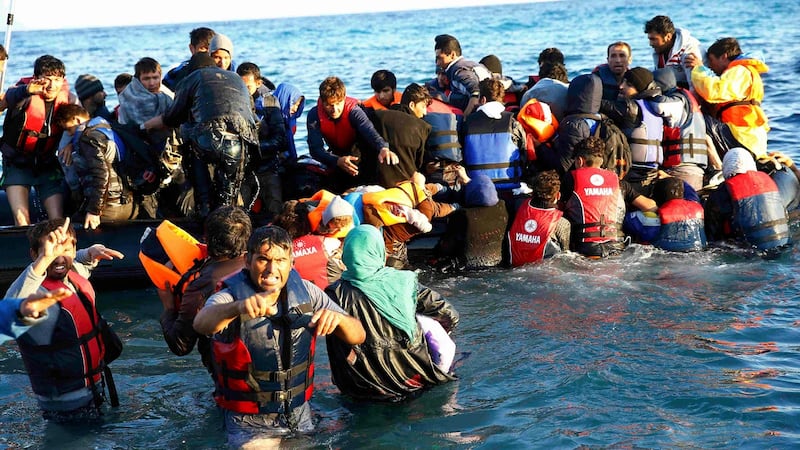When he addressed the Oireachtas last week, Joe Biden evoked the journey into exile of his forebears: “Yesterday, I returned to Co Louth, where I toured the Carlingford Castle, likely one of the last glimpses of Ireland my Finnegan ancestors saw as they gazed on their way out in what, in those days, was referred to as a ‘coffin ship’. And they sailed out of Newry in 1850.”
In an increasingly tribal America, the coffin ship one of the few nonpartisan stories left. Five years ago, the Republican candidate that Biden had faced in the vice-presidential debates of 2012 said pretty much the same thing in 2018: “My family came from Ireland on what they called coffin ships then.”
Except they weren’t called coffin ships then. It is extremely unlikely that Biden’s (or Paul Ryan’s) ancestors used that term – or experienced what it implies.
[ From the Famine ship to the White House – Joe Biden’s Irish ancestryOpens in new window ]
As the historian Cian McMahon points out in his excellent recent study The Coffin Ship, the term “was barely mentioned during the Famine, and became popular among Irish nationalists only in the early 1880s”. It’s a potent phrase – so powerful that it has become a touchstone of Irish-American identity. But it’s a retrospective invention.
READ MORE
The Great Hunger is a scarcely imaginable catastrophe and the transatlantic voyages of often desperate and severely diseased refugees are indelibly imprinted on it. Some of these voyages, especially to Quebec and especially in 1847, were horrendous – in that year about 10 per cent of the 100,000 people who sailed from Ireland to Canada died from disease (usually typhus) on the way.
[ Why are US presidents so drawn to Ireland?Opens in new window ]
But as McMahon points out, “For the more than two million emigrants who did not travel to Canada in 1847 (in other words, for around 95 per cent of all Irish migrants during the Famine years), the average mortality rate generally fell within the ‘normal’ range for Europeans on the high seas in the mid-19th century.”
Many of the Irish migrants experienced nothing more than the considerable discomforts of life in cramped steerage quarters on rough seas. After his voyage from Galway to New York in 1853, one wrote in his diary that “There was one death, that of an infant, and a birth, which left matters just as they were when we left port, at least as far as numbers were concerned.”
Thus, of the 1,920,978 emigrants who left Ireland for destinations beyond Britain between 1845 and 1855, perhaps as many as 47,264 died en route. That’s 2.5 per cent. Every one of those deaths is tragic – but there was nothing unusual at the time in these rates of mortality among poor people on long sea voyages.
[ Great Famine and Irish independence struggle linked by geography and historyOpens in new window ]
Essentially, if you were sailing to America and there was no outbreak of typhus on the ship, you were almost certain to survive the crossing. The ship was not your coffin, it was your mode of delivery.
Does it matter that the US president, speaking in all sincerity, draws on a kind of pseudo-history, a trope that gets endlessly repeated even though it distorts the real experiences of his Finnegan forebears and the vast majority of their peers?

After all, the Famine is so horrific in reality that piling a few more stones of desolation on that mass grave arguably makes little difference to the scale of the suffering.
And the “coffin ships” image is often deployed for decent purposes. Ryan’s statement in 2018 about his ancestors arriving in the US on one was a direct rebuke to then president Donald Trump’s vile language about migrants coming from “shithole countries”. Reminding white Americans that some of their ancestors also came as destitute refugees is a good thing.
Yet there are two reasons to stop using this particular metaphor. One is that there is more than enough distortion of American and Irish history to go around without sustaining yet another falsehood.
Apart from anything else, the “coffin ships” idea devalues the actual experiences of nearly two million Irish people who made that voyage in those years – the real Finnegans and Blewitts. As McMahon puts it, “the picture of Irish emigrants as trapped in ‘coffins’ has stripped them of their liveliness, creativity and agency”.
The other reason is that there are actual coffin ships – in our peripheral vision of today’s world. A staggering 20,000 migrants are known to have died while trying to cross the Mediterranean since 2014. The number is probably a severe underestimate, but the human tragedy as captured so brilliantly in Sally Hayden’s writing for the Irish Times and in her brilliant book, My Fourth Time, We Drowned, is immense.
As Biden knows, hundreds of migrants also drown while trying to cross the Rio Grande from Mexico into Texas. Today’s coffins ships are flimsy boats, rafts, inflatable dinghies.
This is not history, or even pseudo-history. It’s a current reality that most of us prefer not to think about until an especially distressing image (usually the body of a young child) forces it, for a brief moment, into our consciousness.
One of the points of remembering past suffering is to sensitise us to the distress of our fellow human beings in the here-and-now. This makes it all the more important that we remember accurately and stop repeating historical fallacies. Our ancestors deserve better – and so do our contemporaries.













